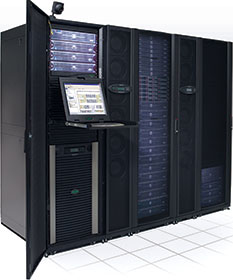

IT deployments for small businesses or branch offices are typically relegated to small confined rooms, closets, or even the general office floor area. A common explanation for this – according to the white paper, “Practical options for deploying small server rooms and micro data centres”, by Schneider Electric – is that “we only had a few pieces of IT equipment so we just put them in here”. This reasoning is fairly justified where there is a low degree of criticality to the business should the IT equipment fail. However, as businesses grow, their reliance on IT solutions by default increases, which inevitably makes them more vulnerable to the availability of these technologies.
Downtime of IT systems can interrupt operations
The research illustrates this vulnerability scenario in an interview with a small food distributor: as the business’ customer base grew, management realised that it was becoming increasingly difficult to fulfil orders on time and accurately without the use of a reliable IT solution. Downtime of IT systems would not only interrupt normal distribution schedules, but would also make it impossible to cater for last minute orders placed by restaurants – some restaurants only need one missed delivery to have a good reason to seek a new distributor. The following are some examples of downtime that were uncovered in this research:
• The IT administrator unplugged a server by accident due to a ‘rat’s nest’ of power and network cabling. To prevent this kind of error being repeated, dual power supplies later became a standard specification for IT server equipment.
• Some IT equipment shut down during a brief power outage – it was later discovered that the equipment was not plugged into the installed uninterruptible power supply (UPS), again mainly due to disorganised cabling behind the rack.
• Forced shutdowns, random equipment failures and reboots due to high temperatures in the room.
• Cleaning staff unplugged a server in order to use a vacuum cleaner.
• A power outage caused all the systems in a branch office IT rack to go down. The IT administrator discovered that the UPS had been signalling for some time that it had a bad battery that required replacement.
Micro data centres address the issues
The white paper highlights that these centres are single, self-contained enclosures that include storage resource, processing equipment and networking hardware necessary to run customer applications. To ensure a seamless solution, these units also contain all necessary power, cooling, security, and associated management (DCIM) tools, and are ultimately able to fulfil equipment load requirements ranging from 1 to 100 kW.
Inherent benefits of using one of these micro data centre units are revealed in the study as:
• They can be scaled to changing IT requirements. As a starting point (and practical example) in terms of compaction, cloud architectures that used to require 10 IT racks, can now fit into one.
• From the perspective of convergence and integration, this solution offers an ‘out of the box’ experience through the seamless containment of all components required.
• Computing latency is significantly reduced (for example between cloud and application).
• Single point of failure is mitigated.
• Reduced deployment time – to either gain a competitive advantage or secure new business.
• Simplified management and maintenance.
• Lower investment and run costs. In many cases, micro data centres can utilise inherent costs, for example facility power (such as switchgear) and cooling (such as chillers).
The white paper also points out that micro data centres are used particularly where applications need to be real time or near real time in terms of data processing – such as factory automation (robots) and industrial automation (cranes). There are applications where the sheer amount of data requires that the processing be on-site to avoid the latency through multiple hubs, such as oil and gas drilling and exploration, construction sites, and large mining sites. The highest volume application on the horizon is a large distributed network of micro data centres that form a content distribution network.
To address the equipment consolidation and compatibility challenge, the study examines the various configuration tools that are available. These tools offer a menu of plausible equipment options without having to research which accessories, services, screws, brackets and more, are required for a particular solution. Buying a UPS, rack, software, management cards, services, and extended warranties separately (that is, without a plausibility/menu view) will always take more time, and result in a much higher risk of procuring incompatible equipment.
Configuration tools ‘understand’ the interoperability of all parts, services, and warranties. In terms of output, they create a bill of materials required for a particular solution. There are two basic methods of shipment after placing an order through these types of tools – everything can ship as individual boxes, or it can ship with the various components pre-mounted inside of the rack. Choosing from standardised, pre-configured solutions also speeds up delivery time because these types of solutions usually tend to be in stock with major suppliers.
“Any business, in particular small businesses, having experienced a downtime event understands the havoc, often costly, it causes in the day-to-day operation. Such an experience generally leads the company to improve on the availability of its IT solution,” says Bruce Grobler, southern African vice president of the IT business unit at Schneider Electric.
The white paper concludes that in many cases, this also spurs new IT upgrade projects. However, although such upgrade projects are usually excellent opportunities to assess the physical environment required to support IT solutions, organisations do not always invest adequate research time to ensure that all environmental factors are properly researched, considered and included in the upgrade plan.
For more information contact Chetan Mistry, Schneider Electric SA, +27 (0)11 254 6400, chetan.mistry@schneider-electric.com, www.schneider-electric.com
| Tel: | +27 11 254 6400 |
| Email: | za-ccc@se.com |
| www: | www.se.com/za/en/ |
| Articles: | More information and articles about Schneider Electric South Africa |
© Technews Publishing (Pty) Ltd | All Rights Reserved